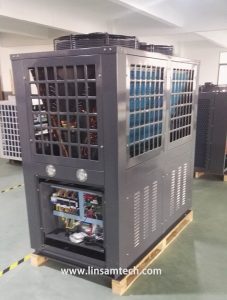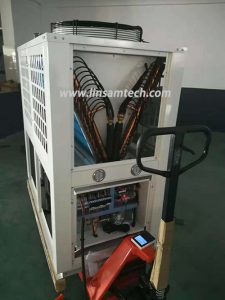Many climates have hot weather. Some places are hot year-round. But that doesn’t mean that the inside of buildings needs to be hot. While the temperature outside can sometimes be over 40degC, the temperature inside the building can be a comfortable 26degC. This is all thanks to the chilled water system.
Chilled water systems are used in medium and large-sized buildings. Chiller plants act as a centralized cooling system that provides cooling for an entire building or even multiple buildings. This is because it is often more practical to centralize air conditioning equipment in one location rather than install many pieces of equipment in many different places.
In addition to simplifying access for a building’s maintenance crew, large water chilled systems also provide greater energy efficiency than smaller, individual systems.
 |  |
There two main types of chilled water cooling systems: air cooled chiller system, and water cooled chiller system.
Air Cooled Chiller System
Air-cooled chillers are almost always located outside of a building and remove heat from the chilled water by exhausting the heat directly to the surrounding air.
Air cooled chiller system exhaust heat from the condenser coil. As warm refrigerant passes through the condenser coil, the outside air blows over the condenser coil and removes heat from the refrigerant.
The refrigerant then passes through an expansion valve, where it rapidly cools and goes through the evaporator, where it cools the chilled water. This process is then repeated all over again.

Water Cooled Chiller Unit
Water-cooled chillers are almost always located inside of a building. They work almost the same way as air-cooled chillers. The difference is that they remove heat from chilled water by exhausting the heat to a second, isolated water line called the condenser water line.
The condenser water flows through the chiller and picks up heat. The condenser water then returns to the cooling tower. The cooling tower is almost always located outside of the building and removes heat from the condenser water by evaporating some of the condenser water into the atmosphere.
As some of the condenser water evaporates, heat is removed from the condenser water, and the cool condenser water flows back to the chiller. This process is then repeated all over again.
![]()
Water-cooled chiller systems are very energy efficient. However, due to their complexity and many different parts, they are often more expensive to install and maintain. For this reason, you will usually only find them in large buildings. This is because the energy savings outweigh the cost of installing and maintaining the system.
However, water-cooled chillers are starting to make an appearance in small buildings as well. Recent advancements have made it practical to install and maintain water-cooled chillers in buildings that usually would not have one.
Water-cooled chiller systems are very energy efficient. However, due to their complexity and many different parts, they are often more expensive to install and maintain. For this reason, you will usually only find them in large buildings. This is because the energy savings outweigh the cost of installing and maintaining the system.
However, water-cooled chillers are starting to make an appearance in small buildings as well. Recent advancements have made it practical to install and maintain water-cooled chillers in buildings that usually would not have one.
